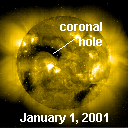|   SPACE WEATHER SPACE WEATHER
Current
Conditions
Solar Wind
velocity: 287.1 km/s
density:5.8 protons/cm3
explanation | history
Updated: Today at 2246 UT
Sunspot Number: 153
More about sunspots
Updated: 31 Jan 2000
Daily Sun: 01 Jan '01 
Sunspot group 9289 exhibits a beta-gamma magnetic field that likely harbors energy for M-class eruptions.
Radio Meteor Rates
24 hr max: 45 per hr
More about these data
Updated: 01 Jan 2001
Interplanetary Mag. Field
Btotal: 7.3 nT
Bz: 2.3 nT south
explanation | history
Updated: Today at 2246 UT Coronal Holes:

A coronal hole north of active region 9289 will cross the Sun's central meridian this week and probably send solar wind gusts toward Earth. Image credit: SOHO Extreme Ultraviolet Telescope.
More about coronal holes
 SPACE WEATHER SPACE WEATHER
NOAA
Forecasts
Solar Flares: Probabilities for a medium-sized (M-class) or a major (X-class) solar flare during the next 24/48 hours are tabulated below.
Updated at 2001 Jan 01 2200 UT
| FLARE | 24 hr | 48 hr | | CLASS M | 40 % | 40 % | | CLASS X | 05 % | 05 % |
Geomagnetic Storms: Probabilities for significant disturbances in Earth's magnetic field are given for three activity levels: active, minor storm, severe storm
Updated at 2001 Jan 01 2200 UT Mid-latitudes | 24 hr | 48 hr | | ACTIVE | 15 % | 25 % | | MINOR | 05 % | 05 % | | SEVERE | 01 % | 01 % |
High latitudes | 24 hr | 48 hr | | ACTIVE | 20 % | 30 % | | MINOR | 10 % | 15 % | | SEVERE | 01 % | 01 % |
|
Space Weather News
Become a Subscriber! Nov. 22, 2000: A Solar Flare Stuns Stardust -- Earlier this month an intense solar radiation storm temporarily blinded NASA's Stardust spacecraft en route to comet Wild-2. Nov. 21, 2000: Leonids Galore -- Find out what happened during the 2000 Leonids meteor shower. Nov. 7, 2000: Much Ado about 2000 SG344 -- In 2071 a relic of NASA's earliest space exploration efforts might return to Earth, if current estimates are confirmed. Oct. 26, 2000: Lunar Leonids -- On Nov. 17, 2000, the moon will plow through a stream of debris from comet Tempel-Tuttle. Oct. 10, 2000: The Moonlit Leonids 2000 -- Our planet is heading for a minefield of cosmic dust streams laid down by periodic comet Tempel-Tuttle. The result could be a series of meteor outbursts on Nov. 17 and 18, 2000. Sept. 28, 2000: Bright Planets and Random Meteors -- This week's new Moon sets a dark stage for a sporadic meteor show featuring a cast of eye-catching stars and planets. Sept. 20, 2000: A Good Month for Asteroids -- Five Near-Earth Asteroids flew past our planet during the month of September. Sept. 13, 2000: A Surprising Coronal Mass Ejection -- A solar filament collapsed and fell to the surface of the Sun, spawning a coronal mass ejection that forecasters didn't expect. Sept. 5, 2000: Sunbathing at Solar Max -- NASA scientists say that solar maximum is now in full swing. Does that mean you're more likely to suffer a sunburn at the beach? This story reveals the answer.
MORE SPACE WEATHER HEADLINES |



